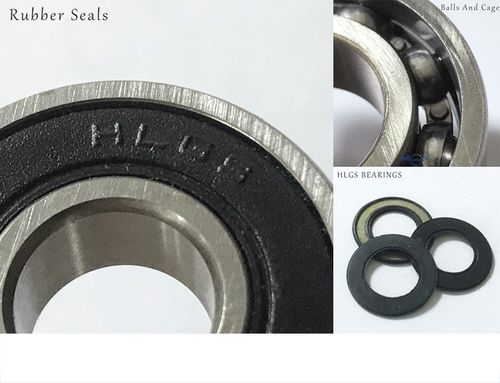Marine Corrosion Proof Bearings: Essential Guide for Durability and Performance
Marine corrosion proof bearings are engineered to withstand harsh saltwater environments, ensuring longevity and reliability in maritime applications. These specialized bearings utilize anti-corrosive materials like stainless steel or ceramic coatings to resist oxidation, chemical exposure, and abrasive wear. Ideal for ships, offshore platforms, and marine equipment, they play a pivotal role in reducing maintenance costs and preventing operational failures.
Table of Contents
1. marine bearing materials for saltwater2. stainless steel marine bearings vs ceramic
3. how to maintain boat bearings in seawater
4. best corrosion resistant bearings for offshore rigs
5. marine bearing failure causes and solutions
1. Marine Bearing Materials for Saltwater

Selecting the right materials is critical for marine bearings exposed to saltwater. Stainless steel (AISI 316/316L) remains the gold standard due to its exceptional resistance to pitting and crevice corrosion. For extreme conditions, duplex stainless steels or nickel-aluminum bronze alloys offer enhanced strength. Ceramic hybrid bearings, featuring zirconia or silicon nitride balls, eliminate galvanic corrosion risks entirely. Polymer-coated bearings with PTFE or PEEK layers provide additional protection against abrasive particles. Engineers must evaluate load capacity, temperature ranges, and chemical compatibility when specifying materials for propeller shafts, rudder systems, or winch mechanisms in marine vessels.
2. Stainless Steel Marine Bearings vs Ceramic
Stainless steel bearings dominate marine applications due to their cost-effectiveness and mechanical robustness. AISI 440C bearings withstand moderate salinity but require regular lubrication. In contrast, ceramic bearings excel in completely submerged environments—their non-porous surface prevents salt crystallization, reducing friction by up to 40%. While ceramic options have higher upfront costs, they eliminate lubrication needs and last 3-5x longer in continuous saltwater exposure. Hybrid designs combining stainless steel races with ceramic balls balance durability and affordability. Recent advancements in graphene-infused stainless steel composites show promise for next-generation marine bearings with self-lubricating properties.
3. How to Maintain Boat Bearings in Seawater
Regular maintenance extends marine bearing lifespan significantly. Conduct monthly visual inspections for rust spots or pitting. Flush bearings with fresh water after saltwater exposure using high-pressure nozzles. For lubricated systems, replace grease every 500 operating hours with marine-grade products containing molybdenum disulfide. Ultrasonic testing helps detect early-stage corrosion under seals. Implement cathodic protection systems on bearing housings to counteract galvanic corrosion. Always store spare bearings in climate-controlled environments with desiccant packs. Upgrade to sealed-for-life bearings if frequent maintenance isn’t feasible—modern triple-lip seals retain lubrication while blocking 99.7% of contaminants.
4. Best Corrosion Resistant Bearings for Offshore Rigs
Offshore rigs demand bearings that survive prolonged immersion and high shock loads. For drill string rotating heads, choose bearings with Hastelloy C-276 races and tungsten carbide rollers—these withstand H2S-rich environments and pH extremes. Mooring system bearings require duplex stainless steel with PREN >40 for crevice corrosion resistance. Thruster azimuth bearings benefit from titanium alloy cages and PEEK polymer retainers. Always specify ISO 19906-compliant designs for Arctic operations where temperatures plunge below -40°C. Recent field tests show laser-clad bearings with Inconel 625 coatings achieving 15-year lifespans in North Sea platforms.
5. Marine Bearing Failure Causes and Solutions
Premature marine bearing failures often stem from improper material selection (35% of cases) or inadequate sealing (28%). Galvanic corrosion accelerates when dissimilar metals contact saltwater—install dielectric spacers between bronze bearings and steel shafts. Fatigue spalling indicates overload; upgrade to bearings with higher dynamic load ratings. Microbiologically influenced corrosion (MIC) can be mitigated using silver-ion infused lubricants. For cavitation damage in propeller shafts, switch to bearings with hardened surfaces like Stellite 6B overlays. Implement IoT-enabled vibration sensors to detect alignment issues early—smart bearings transmitting real-time data reduce unplanned downtime by 62%.
Understanding these five critical aspects of marine corrosion proof bearings empowers maritime engineers to make informed decisions. From material science breakthroughs to predictive maintenance technologies, each innovation addresses specific challenges in saltwater environments. Whether you're retrofitting a fishing vessel or specifying bearings for a new offshore wind farm, balancing corrosion resistance with mechanical performance is paramount. Explore our technical guides on seal optimization and lubrication strategies to further enhance your marine systems' reliability.
In conclusion, marine corrosion proof bearings represent a fusion of advanced metallurgy and precision engineering. By selecting appropriate materials, implementing rigorous maintenance protocols, and leveraging modern monitoring systems, operators can dramatically extend equipment service life in corrosive marine environments. Always consult bearing manufacturers for application-specific recommendations to ensure optimal performance and regulatory compliance.




 13869596835
13869596835